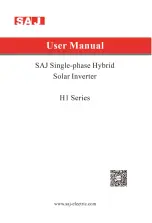
4.6 Motor Cables
See
chapter 7.2 General Specifications
for correct
dimensioning of motor cable cross-section and length. See
chapter 4.10.1 EMC Emission
for relationship between
length and EMC emission.
Always comply with national and local regulations on
cable cross-section.
NOTICE
If an unscreened/unarmoured cable is used, some EMC
requirements are not complied with. Refer to
chapter 4.10.1 EMC Emission
for more details.
To comply with the EMC specifications regarding emission,
the motor cable must be screened/armoured, unless
otherwise stated for the RFI filter in question. It is
important to keep the motor cable as short as possible so
as to reduce the noise level and leakage currents to a
minimum. Connect the motor cable screen to the metal
cabinet of the frequency converter and to the metal
cabinet of the motor. Make the screen connections with
the biggest possible surface area (cable clamp). This is
enabled by different installation devices in different
frequency converters. Avoid mounting with twisted screen
ends (pigtails), since these spoil the screening effect at
high frequencies. If it is necessary to break the screen to
install a motor isolator or motor relay, the screen must be
continued at the lowest possible HF impedance.
4.7 Motor Thermal Protection
The electronic thermal relay in the frequency converter has
received the UL-approval for single motor protection,
when parameter
128 Motor thermal protection
has been set
for
ETR Trip
and parameter
105 Motor current, I
M, N
has been
programmed to the rated motor current (see motor
nameplate).
4.8 Control Cables
Remove the front cover underneath the control panel.
Place a jumper between terminals 12 and 27.
Control cables must be screened/armoured. The screen
must be connected to the frequency converter chassis with
a clamp. Normally, the screen must also be connected to
the chassis of the controlling unit (use the instructions for
the unit in question). In connection with very long control
cables and analog signals, in rare cases depending on the
installation, 50/60 Hz ground loops may occur because of
noise transmitted from mains supply cables. In this
connection, it may be necessary to break the screen and
possibly insert a 100 nF capacitor between the screen and
the chassis.
See section
Grounding of Screened/Armoured control cables
in the
Design Guide
for the correct termination of control
cables.
Illustration 4.8 Control Cable Connection
Electrical Installation
Quick Guide
MG28M202
Danfoss A/S © Rev. 2014-03-18 All rights reserved.
13
4
4
















































